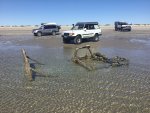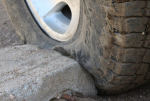...That's not how I travel;
IMO; First rule for people with less experience or vehicles that are not modified for optimum safety and traction;
Bring a sensible, well experienced friend in a well set up vehicle so they can guide, help, instruct (& possibly help recover) you/your vehicle... If one or more tires spin its an indicator that upgrades are needed.
In my experience (around 40 years off road, in many vehicles, on/in most terrains), normally; for stock and near stock (average) vehicle (AWD or 4wd) airing down is a band-aid attempt to make up for the lack of traction developed by the less good (street/all terrain) tires that came on the vehicle or were selected by folks who would rather have quiet ride than traction or have been convinced that some tire gives longer life, (again at the expense of traction).
Airing down has long been the cheapest way to get a traction gain; I do not dis-recommend it; but to imply that airing down is some how safer is not something that I would do.
(The traction gained could get a neophyte into a situation that is more than they are prepared to safely do, IMO)... loose/slippery downhills are one possible exception and an incentive to use at least aggressive tread, medium traction tires, i.e. BFG mud tires or similar, for example.
The experienced travelers in well set up vehicles will sometime air down to increase flotation or/tire footprint in soft terrains, with good effect.
The very difficult to extreme trail crowd normally has the experience, safety equipment and vehicles that are good enough to make airing down a method to gain that last few percent of traction necessary to make the obstacle or roll/flop trying (not a big deal; after the first couple of times for these guys/girls, put it back on its tires and keep on wheeling).
Airing down is not a fix for poor/unsafe vehicle prep/driving techniques/experience ... nor lack of common sense, IMO.
Enjoy!
I can agree and appreciate most of that, but I like not having my vehicle beat the snot out of me on anything rougher than a recently smoothed NFS road. Unless you're running extremely nice and expensive shocks with well tuned springs you'll want to not only slow down but also air down to keep your rig from not just beating you to a pulp but itself as well.
Airing down isn't just for traction, it's also to soften the impacts of a rough trail. And that isn't just so that you can go barreling down the trail at high speed. In my experience (which granted isn't as much as yours), unless you crawl around at 10mph (or slower for some trails) all the time, keeping tires inflated to highway pressures will result in excessive fatigue, strained muscles and joints, decreased safety and handling (caused by the vehicle bouncing all over the place due to a combination of too much speed and too much pressure in the tires, though too little can also result in unsafe handling at higher speeds than the pressure is meant for) as well as damage to the vehicle as a whole due to stresses it wasn't designed to handle, shock fade and excess wear, increased spring wear, etc, etc.
While passenger tires shouldn't be aired down very much, if at all, due to much weaker construction than beefier LT and offroad tailored tires, 5psi less than street is probably enough to noticeably decrease ride harshness while offroad without overly increasing the risk of sidewall damage. When running heavier duty tires designed primarily for offroad use (MT's, aggressive AT's, and even decent AT's) you can air down more to not just increase traction but also help lessen impacts to a more manageable rate for the shocks (and your body) to handle.
That being said, finding appropriate pressures for your rig and the terrain you are covering is important. Keeping the sidewalls from overheating is critical to properly airing down, as my understanding is that it's the heat from repeatedly flexing that ultimately kills them, more than just the flexing by itself. The lower the pressure you use, the more the sidewall flexes, so the slower you need to go to keep the sidewalls from overheating and becoming damaged. At low pressures if the speed is low the rate the sidewall flexes is overall lower which is why generally speaking you can safely lower tire pressures without damaging the tire. For example, 15psi at 20mph (for my rig and tire combo) is just fine and likely doesn't wear the tires out any more than keeping them at highway pressure and driving 80mph. A good method I've seen is to lower pressure and drive for a bit. Then get out and feel the sidewalls to see how warm they are. They should not feel hot or even overly warm. If they are the pressure is probably too low for the terrain and speeds you are going which is causing the sidewalls to flex too much and heat up. You'll need to either increase the pressure or slow down.
Also, lower pressures allow the tread and sidewalls to deflect more when pressed against sharper objects like rocks and sticks which helps with preventingpunctures and other damage. Cooper tires did a good video demonstrating this with three of their tires, a Highway Tread (HT), an AT, and a MT. The lower the pressure used the more times each tire could be run over a spike without being punctured. Obviously there was a huge difference between the HT tire and their AT, and an even bigger one with their MT. But even the HT was able to withstand the spike better at lower pressures.
But, if you like having your teeth and every bolt in your rig rattle as you go down a trail, by all means keep them fully inflated. You don't *have* to air down while offroad, but I would strongly suggest it.

Sent from my SM-N975U using Tapatalk






